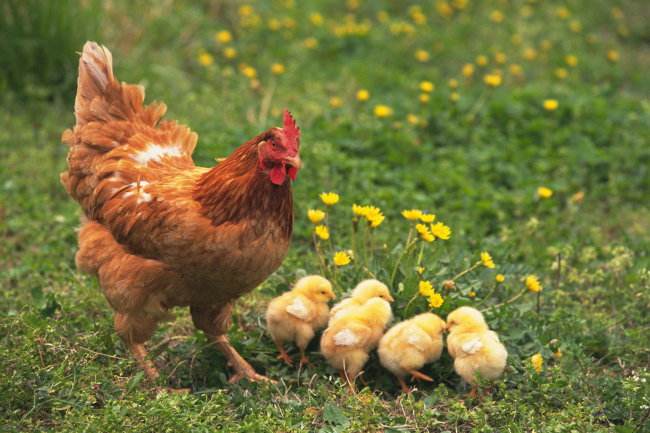(单词翻译:单击)
听力文本
This is Scientific American — 60-Second Science. I'm Karen Hopkin.
Why did the chicken cross the road? Well, that's a philosophical pickle. But if you want to know why chickens don't get cross at people—why they're content being kept in their coops—science can help.
"Domestic species are interesting because their genetic makeup has changed dramatically as part of the process of going from wild to domestic."
Liisa Loog, an evolutionary geneticist and anthropologist at the Universities of Oxford and Cambridge.
"And indeed when people have compared modern domestic animals with their wild relatives they've identified genes that do show signs of strong recent selection. One such gene is thyroid stimulating hormone receptor, otherwise known as TSHR...in chickens, a variant of this gene that is widespread in modern populations has been shown to directly cause chickens to be less fearful of humans and also result in reduced aggression towards conspecifics."
But when exactly did the selection for these traits—and therefore this variant—take place?
"It's been suggested because of the potential usefulness of these traits in domestic setting that selection on this gene must have happened when chickens were first domesticated around 6,000 years ago in East Asia. But in an evolutionary timescale this is just a blink of an eye and we just don't know and don't have the resolution to tell when exactly between 6,000 years ago and now this selection happened, using data from only modern chicken populations...but with DNA from archaeological material we can follow what happened with a gene through time and in theory spot when changes in a population occur."

Loog and her colleagues examined TSHR gene sequences in the ancient remains of about 60 chickens found in Europe "and estimated that selection at this TSHR locus happened only around 1,000 years ago, at medieval times." That is, 5,000 years after the initial domestication of chicken.
"Interestingly this time period coincides with a...substantial increase in chicken consumption known from the archaeological record. Historians suggest that a key driver behind these changes was the rising popularity and spread of Christian traditions, which discouraged and also on occasions even banned eating meat from four-legged animals."
But fowl were fair game.
"What is really exciting about this new study is that for the first time we can directly link genetic changes in domestic animal with cultural shifts in human food preference." The findings appear in the journal Molecular Biology and Evolution.
This kind of plucky study is not just for the birds. Loog says the team is collecting canine archaeological samples, so they can look at how man's best friend got divvied up into so many different breeds. Their research will no doubt be dogged.
Thanks for listening for Scientific American — 60-Second Science Science. I'm Karen Hopkin.
参考译文
这里是科学美国人——60秒科学。我是凯伦·霍普金。
鸡为什么过马路?这是一个哲学谜题。但是,如果你想知道鸡为什么不生人类的气,为什么甘于被关在笼子里,那科学家可以帮你解答。
“家养物种很有趣,因为在从野生到家养的驯化过程中,它们的基因组成发生了巨大变化。”
牛津大学和剑桥大学的进化遗传学家和人类学家莉萨·卢格说。
“的确,当人类将现代家畜与其野生亲属进行比较时,发现了展现强烈近期选择迹象的基因。其中一种基因是促甲状腺激素受体,也被称为TSHR,这种基因的变种广泛存在于现代鸡群体内,它已被证明是使鸡不怎么害怕人类的直接原因,而且它还使鸡对同类个体的攻击性减少。”
但是这些特性的选择以及这种变体到底是什么时候发生的?
“由于这些特性在家养环境中存在潜在作用,有人认为这种基因选择一定发生在6000年前,也就是东亚首次驯养鸡开始。但是在进化时间表中,这就是一瞬之间,只使用现代鸡群的数据,我们无法知道也不能分辨出这种基因选择是在6000年中具体哪个时间点发生的,但是,利用从考古材料中提取的DNA,我们可以追踪一种基因在时间长河中发生的变化,并在理论上确定一个种群发生变化的时间。”
卢格和同事们研究了TSHR基因序列,这些基因序列来自在欧洲发现的60只鸡的古代遗骸,“据估计TSHR基因选择的发生时间仅为约1000年前的中世纪”。也就是在鸡类最初被驯化的5000年以后。
“有趣的是,这一时期与从考古记录中发现的鸡肉消耗大幅增加的时间相吻合。历史学家认为,这些变化背后的关键驱动因素是基督教传统的日益盛行和传播,这些传统劝阻人们、有时甚至会禁止人们食用四足动物的肉。”
而家禽却不在禁止食用之列。
“这项新研究真正令人兴奋的是,我们第一次可以将家禽的基因变化与人类食物偏好的文化转变直接联系起来。”这项研究发表在《分子生物学与进化学》期刊上。
这种大胆的研究不仅限于禽类。卢格表示,她的团队正在收集犬类考古样品,准备研究人类最好的朋友是如何被分成那么多不同品种的。他们的研究无疑会备受关注。
谢谢大家收听科学美国人——60秒科学。我是凯伦·霍普金。
译文为可可英语翻译,未经授权请勿转载!
重点讲解
重点讲解:
1. be fearful of 恐惧的;害怕的;
例句:They are fearful of another business depression.
他们担心会再次发生商业萧条。
2. in theory 从理论上说;照理说;
例句:A school dental service exists in theory, but in practice, there are few dentists to work in them.
照理说,学校也有牙医诊所,可实际上,里面的牙医寥寥无几。
3. coincide with 巧合;同时发生;
例句:The exhibition coincides with the 50th anniversary of his death.
展览恰好在他逝世50周年之际举行。
4. no doubt 无疑地;必定;
例句:They have the usual quota of human weaknesses, no doubt.
毫无疑问,他们身上也有人所共有的弱点。


